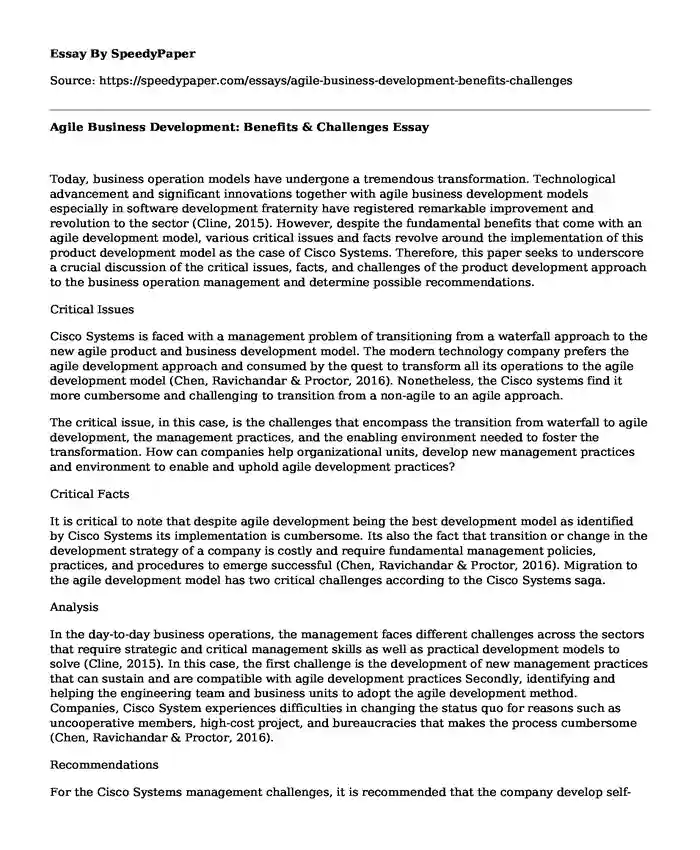
| Type of paper: | Case study |
| Categories: | Management Business Technology |
| Pages: | 3 |
| Wordcount: | 661 words |
Today, business operation models have undergone a tremendous transformation. Technological advancement and significant innovations together with agile business development models especially in software development fraternity have registered remarkable improvement and revolution to the sector (Cline, 2015). However, despite the fundamental benefits that come with an agile development model, various critical issues and facts revolve around the implementation of this product development model as the case of Cisco Systems. Therefore, this paper seeks to underscore a crucial discussion of the critical issues, facts, and challenges of the product development approach to the business operation management and determine possible recommendations.
Critical Issues
Cisco Systems is faced with a management problem of transitioning from a waterfall approach to the new agile product and business development model. The modern technology company prefers the agile development approach and consumed by the quest to transform all its operations to the agile development model (Chen, Ravichandar & Proctor, 2016). Nonetheless, the Cisco systems find it more cumbersome and challenging to transition from a non-agile to an agile approach.
The critical issue, in this case, is the challenges that encompass the transition from waterfall to agile development, the management practices, and the enabling environment needed to foster the transformation. How can companies help organizational units, develop new management practices and environment to enable and uphold agile development practices?
Critical Facts
It is critical to note that despite agile development being the best development model as identified by Cisco Systems its implementation is cumbersome. Its also the fact that transition or change in the development strategy of a company is costly and require fundamental management policies, practices, and procedures to emerge successful (Chen, Ravichandar & Proctor, 2016). Migration to the agile development model has two critical challenges according to the Cisco Systems saga.
Analysis
In the day-to-day business operations, the management faces different challenges across the sectors that require strategic and critical management skills as well as practical development models to solve (Cline, 2015). In this case, the first challenge is the development of new management practices that can sustain and are compatible with agile development practices Secondly, identifying and helping the engineering team and business units to adopt the agile development method. Companies, Cisco System experiences difficulties in changing the status quo for reasons such as uncooperative members, high-cost project, and bureaucracies that makes the process cumbersome (Chen, Ravichandar & Proctor, 2016).
Recommendations
For the Cisco Systems management challenges, it is recommended that the company develop self-organizing teams. The company should also endeavor to coordinate in the agile development process; interim coordination is necessary to reconfigure engineering teams as well as co-locating engineers to achieve the transition goals (Davis, 2013).
Effective of Recommended Decisions
For the case, Cisco Systems, the creation of self-organizing teams such as the Agile Trigger Team (ATT) work with business units on potential benefits of adopting agile development.
Execution
Cisco systems solve the challenges through the Agile Trigger Team (ATT) to enlighten the business units on the benefits of adopting an agile approach and motivate the organization units towards achieving the company's objective (Cline, 2015).
Scenario Planning
The problem, in this case, is the challenge involved in the transition and implementation processes new agile development, which includes the development of new management practices and environment to enable and support agile development practices, which can be solved by developing self-organizing teams to foster the transition process (Cline, 2015).
In conclusion, everyday business operations management experience different challenges that require more insightful ideas and correct development project to overcome. Agile software development is the most preferred model by most firms because it is a modern method and a holistic approach. The challenges make the product and business transition models cumbersome despite their effectiveness and functionality; thus, critical recommendation is necessary.
References
Chen, R., Ravichandar, R., & Proctor, D. (2016). Managing transition to the new agile business and product development model: Lessons from Cisco Systems (pp. 635-644). Fulton Street, San Francisco, CA 94117, U.S.A: University of San Francisco. Retrieved from http://www.sciencedirect.com
Cline, A. (2015). Agile development in the real world. Berkeley, CA: Apress.
Cite this page
Agile Business Development: Benefits & Challenges. (2022, Dec 27). Retrieved from https://speedypaper.com/essays/agile-business-development-benefits-challenges
Request Removal
If you are the original author of this essay and no longer wish to have it published on the SpeedyPaper website, please click below to request its removal:
Popular categories




